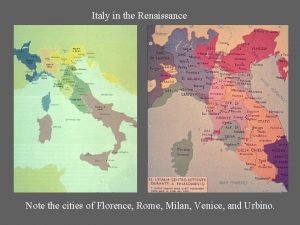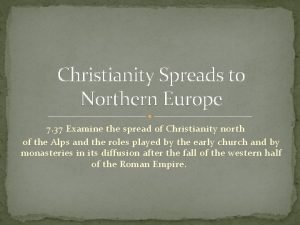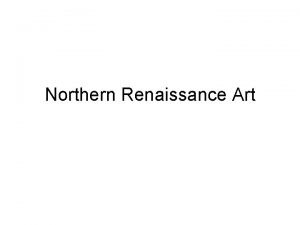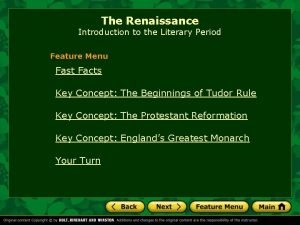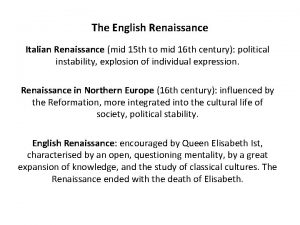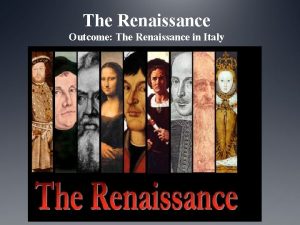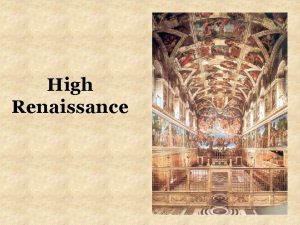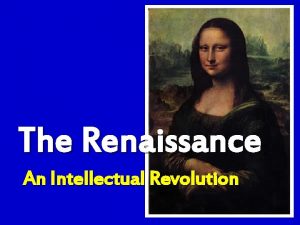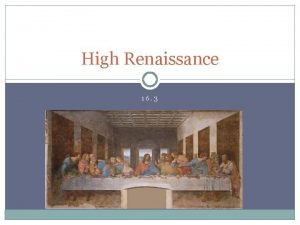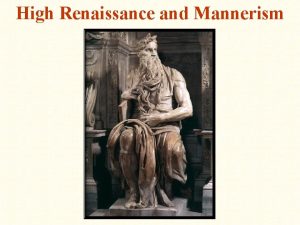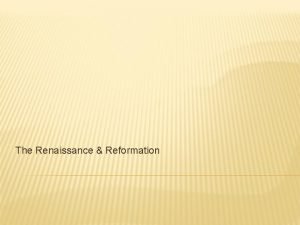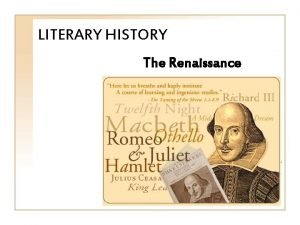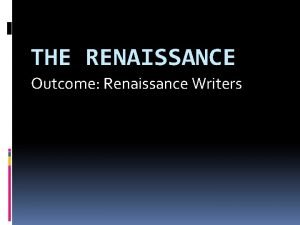THE HIGH RENAISSANCE What Defined the High Renaissance
















- Slides: 16

THE HIGH RENAISSANCE

What Defined the High Renaissance? ■ The High Renaissance occurred between 1495 and 1527. ■ da Vinci, Michelangelo, and Raphael produced a lot of the artwork that defined this period. Ø They were frequently hired by "the popes of Rome to create ambitious artworks that glorified religious themes. " ■ Much of the art that was produced was created in Italy.

Leonardo da Vinci ■ Leonardo da Vinci lived between 1492 and 1519. ■ He was the illegitimate child of a well-known Tuscan family of "potters and notaries. " ■ da Vinci demonstrated artistic talent at an early age. ■ Through working as an apprentice for the Florentine artist Verrocchio at the age of 17, da Vinci developed his artistic abilities and learned about prominent artists. ■ 1472: da Vinci became a member of the artists’ guild, Compagnia di San Luca. ■ During his life, he took an interest in a wide range of topics that included: architecture, mathematics, sculpture, painting, anatomy, poetry, literature, music, geology, botany, and hydraulics. ■ Law breaker: He dissected cadavers even though the practice was illegal.

Think-Pair-Share: ■ Why might an artist choose to dissect a cadaver?

da Vinci's Notebooks ■ Historians estimate that Leonardo da Vinci used as many as 120 notebooks to draw and examine various subjects he was interested in. ■ The topics in his notebooks "range from anatomy to storm clouds to rock formations to military fortifications. " ■ The figure on the left is called Superficial anatomy of the shoulder and neck, c. 1510, pen and ink over black chalk, 29. 2 x 19. 8 cm (Royal Collection trust, UK)

Leonardo: Anatomist ■ https: //www. khanacademy. org/humanities/renaissance-reformation/high-renflorence-rome/leonardo-da-vinci/v/leonardo-anatomist

The Last Supper ■ Leonardo da Vinci completed The Last Supper between 1495 - 1498. ■ Da Vinci applied the laws of linear perspective to this painting. ■ The main focal and vanishing point is Christ. ■ The painting depicts the moment when Christ announced that one of his apostles would not remain loyal to him. ■ Breaking with tradition: da Vinci included Judas with the other apostles. ■ Question: Which apostle is supposed to be Judas?

Video clip: The Last Supper ■ https: //www. khanacademy. org/humanities/ap-art-history/early-europe-andcolonial-americas/renaissance-art-europe-ap/v/leonardo-da-vinci-last-supper 1495 -98

Mona Lisa ■ Mona Lisa was created by Leonardo da Vinci around 1503 - 1506. ■ da Vinci used oil paint on wood for this work of art. ■ This portrait painting was still in the possession of da Vinci when he died. ■ Historians believe da Vinci likely spent 16 years working on this portrait. ■ Discussion: According to da Vinci, "the eyes are the windows to the mind. " What do you think he meant by this? How is this statement applicable to da Vinci's work, Mona Lisa?

Michelangelo ■ Michelangelo lived between 1475 and 1564. ■ Michelangelo's family was in the banking business. ■ When it became apparent that Michelangelo had no interest in his family's business, he was given the opportunity to work as an apprentice to a painter. Ø During this period, he studied the "technique of fresco. " ■ Michelangelo was given the privilege of studying the sculpture gardens of the Medici family. ■ During his long life, he explored a range of fields, including sculpture, painting, and poetry. ■ He was known as "il divino, " meaning "the divine one. " Ø A lot of the artwork he produced seemed "superhuman. "

Pieta ■ A Pieta is a "work showing Mary mourning over the body of Christ. " ■ The sculpture on the left was created by Michelangelo in 1500 out of marble. It is titled Pieta. ■ It shows the Virgin Mary seated at the foot of the cross with the crucified Christ in her lap. ■ Think-Pair-Share: Why do you think Michelangelo made the woman so much larger than the man? What emotions are

David ■ This sculpture was completed by Michelangelo in 1504 when he was in his late 20's. ■ He used a block of marble called 'The Giant' to create this masterpiece. ■ The sculpture is 17 feet tall. ■ It represents the biblical figure David. ■ Michelangelo purposely made the statue large. Ø David "was special to the citizens of Florence—he symbolized the liberty and freedom of their republican ideals, which were threatened at various points in the fifteenth century by the Medici family and others. "

The Sistine Chapel § Michelangelo was commissioned by Pope Julius II to paint the ceiling of the Sistine Chapel in the Vatican. § Initially, Michelangelo was insulted when he was asked to complete the project. Ø At the time, "ceiling paintings were considered less important than wall paintings. " § After 4 years of dedication, Michelangelo completed the Sistine ceiling in 1512. § The end result: A fresco that contained 145 pictures with over 300 figures were featured on the ceiling. § Video of 500 th anniversary: https: //www. youtube. com/watch? v=Fwl 640 Yc 6 JM

Raphael ■ Raphael lived between 1483 and 1520 in Italy. ■ During his childhood, he worked as an apprentice for a highly regarded artist. Ø This taught him how to "use soft colours, simple circular forms, and gentle landscapes. " ■ He often looked to da Vinci and Michelangelo for inspiration. Ø Da Vinci: He "learned how to use shading to create the illusion of three-dimensional form. " Ø Michelangelo: He "learned how to add vitality and engergy to his figures. "

■ The School of Athens Raphael completed this work of art between 1509 and 1511. ■ He was commissioned by Pope Julius II to paint several rooms within the Vatican Palace. ■ The School of Athens was one of the frescos that Raphael completed for this project. ■ This work "represents all the greatest mathematicians, philosophers and scientists from classical antiquity gathered together sharing their ideas and learning from each other. " Ø Plato and Aristotle are the main focal points in the centre. Ø Analysis: "Plato points up because in his philosophy the changing world that we see around us is just a shadow of a higher, truer reality that is eternal and unchanging. " Ø Analysis: "Aristotle holds his hand down, because in his philosophy, the only reality is the one that we can see and experience by sight and touch. "

Sources ■ Mittler, G. (2006). Art in Focus. Mc. Graw-Hill. ■ https: //en. wikipedia. org/wiki/Piet%C 3%A 0_(Michelangelo) ■ https: //en. wikipedia. org/wiki/The_Last_Supper_(Leonardo_da_Vinci) ■ https: //www. khanacademy. org/humanities/renaissance-reformation/high-ren-florencerome/leonardo-da-vinci/a/about-leonardo ■ https: //www. khanacademy. org/humanities/renaissance-reformation/high-ren-florencerome/michelangelo/a/michelangelo-sculptor-painter-architect-and-poet ■ https: //www. khanacademy. org/humanities/ap-art-history/early-europe-and-colonialamericas/renaissance-art-europe-ap/a/raphael-school-of-athens ■ https: //www. biography. com/people/michelangelo-9407628
 What do you call a collection of well-defined objects
What do you call a collection of well-defined objects Last supper labeled
Last supper labeled The renaissance outcome the renaissance in italy
The renaissance outcome the renaissance in italy Italian renaissance vs northern renaissance venn diagram
Italian renaissance vs northern renaissance venn diagram The renaissance outcome renaissance painters/sculptors
The renaissance outcome renaissance painters/sculptors Flemish renaissance art characteristics
Flemish renaissance art characteristics The renaissance introduction to the renaissance answer key
The renaissance introduction to the renaissance answer key Italian renaissance vs english renaissance
Italian renaissance vs english renaissance The renaissance outcome the renaissance in italy
The renaissance outcome the renaissance in italy Hát kết hợp bộ gõ cơ thể
Hát kết hợp bộ gõ cơ thể Slidetodoc
Slidetodoc Bổ thể
Bổ thể Tỉ lệ cơ thể trẻ em
Tỉ lệ cơ thể trẻ em Voi kéo gỗ như thế nào
Voi kéo gỗ như thế nào Glasgow thang điểm
Glasgow thang điểm Hát lên người ơi
Hát lên người ơi Các môn thể thao bắt đầu bằng tiếng chạy
Các môn thể thao bắt đầu bằng tiếng chạy

